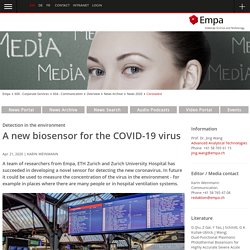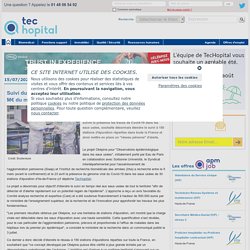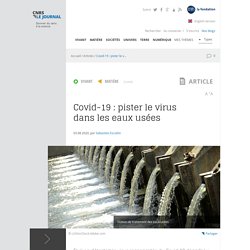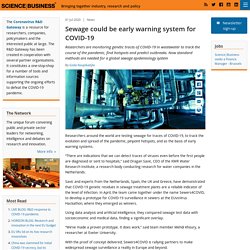

105 pandemiemanagement. Coron-A. Biosensor to detect Coronavirus in the air - ETHZ / EMPA. However, it is important that only those RNA strands that match exactly the DNA receptor on the sensor are captured.

This is where a second effect comes into play on the sensor: the plasmonic photothermal (PPT) effect. If the same nanostructure on the sensor is excited with a laser of a certain wavelength, it produces localized heat. And how does that help reliability? As already mentioned, the genome of the virus consists of only a single strand of RNA. If this strand finds its complementary counterpart, the two combine to form a double strand - a process called hybridization. To demonstrate how reliably the new sensor detects the current COVID-19 virus, the researchers tested it with a very closely related virus: SARS-CoV.
At the moment, however, the sensor is not yet ready to measure the corona virus concentration in the air, for example in Zurich's main railway station. Suivi du Covid dans les eaux usées: le projet Obépine reçoit 3 M€ du ministère de la recherche et étend son réseau. Le projet Obépine pour "Observatoire épidémiologique dans les eaux usées", initialement porté par Eau de Paris en collaboration avec Sorbonne Université, le Syndicat interdépartemental pour l'assainissement de l'agglomération parisienne (Siaap) et l'Institut de recherche biomédicale des armées (Irba) a recherché entre le 5 mars (avant le confinement) et le 23 avril la présence du génome viral du Covid-19 dans les eaux usées de 30 stations d'épuration d'Ile-de-France (cf dépêche TecHopital).

Le projet a désormais pour objectif d'étendre le suivi en temps réel aux eaux usées de tout le territoire "afin de détecter et d'alerter rapidement sur un potentiel regain de l'épidémie". L'approche a reçu un avis favorable du Comité analyse recherche et expertise (Care) et a été soutenue financièrement à hauteur de 500.000 euros par le ministère de l'enseignement supérieur, de la recherche et de l'innovation pour approfondir les travaux les plus fondamentaux. gdl/nc. Covid-19 : pister le virus dans les eaux usées. Et si on détectait le virus responsable du Covid-19 dans l'eau des égouts pour anticiper de prochaines vagues ?

La concentration du pathogène, rejeté dans les selles, pourrait en effet permettre de mettre au point un système d’alerte précoce pour toute la France. C'est le but du projet Obépine. Au 5 mars 2020, il n’y avait qu’une petite dizaine de patients Covid-19 identifiés à Paris. Pourtant, le nouveau coronavirus était déjà détectable dans les égouts de la ville.
Si, ce jour-là, quelqu’un avait pu analyser les eaux usées, il aurait su que ce petit nombre de tests positifs était un leurre : Paris était déjà gravement atteint et la vague d’hospitalisations allait très vite déferler. Au cours du mois, avec les services de santé sous haute tension, la concentration du virus dans les eaux usées parisiennes s’est multiplié par plus de cent. Le virus était déjà détectable dans les égouts de Paris avant la vague d'hospitalisation. Se donner un temps d'avance sur le virus. Sewage could be early warning system for COVID-19. Researchers around the world are testing sewage for traces of COVID-19, to track the evolution and spread of the pandemic, pinpoint hotspots, and as the basis of early warning systems.

“There are indications that we can detect traces of viruses even before the first people are diagnosed or sent to hospitals,” said Dragan Savic, CEO of the KWR Water Research Institute, a research body conducting research for water companies in the Netherlands. Savic and experts from the Netherlands, Spain, the UK and Greece, have demonstrated that COVID-19 genetic residues in sewage treatment plants are a reliable indicator of the level of infection. In April, the team came together under the name Sewers4COVID, to develop a prototype for COVID-19 surveillance in sewers at the EUvsVirus Hackathon, where they emerged as winners. Using data analysis and artificial intelligence, they compared sewage test data with socioeconomic and medical data, finding a significant overlap. “We’ve made a proven prototype.